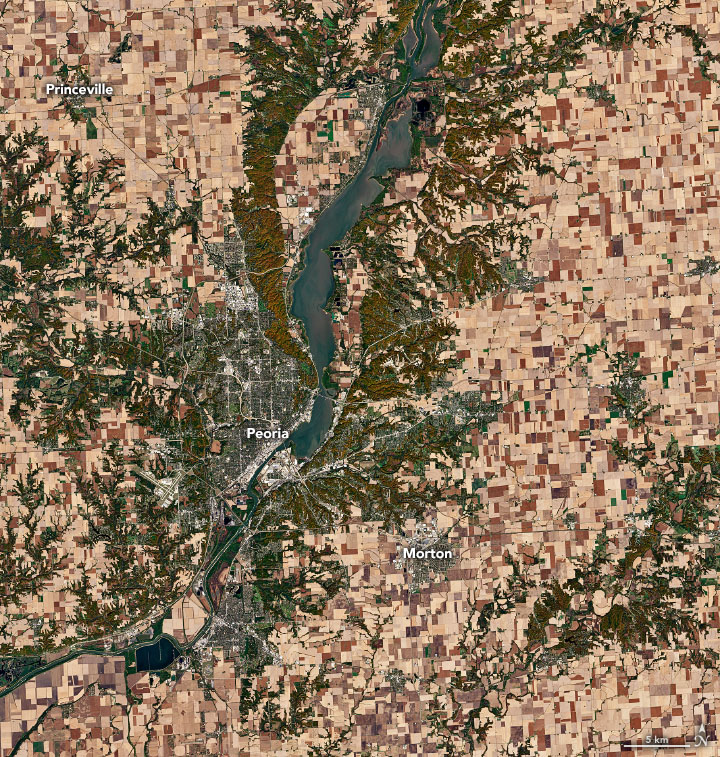
From Patches to Pies, Illinois Knows Pumpkins
Downloads
- illinois_oli_2022295_lrg.jpg (7601x7731, JPEG)
Metadata
- Sensor(s):
- Landsat 8 - OLI
- Data Date: October 22, 2022
- Visualization Date: November 21, 2022
Pumpkins, a type of winter squash native to the southwestern United States and northern Mexico, are among the oldest domesticated plants. Archaeological evidence indicates that several different species of pumpkins were independently domesticated between 4,000 and 10,000 years ago in different parts of North, Central, and South America.
Modern-day pumpkins are quite a bit different than their wild forerunners, which were small, bitter, gourd-like, and mainly eaten by mammoths and mastodons. As humans started to sample and replant the best-tasting of them, modern pumpkins have come to be considerably larger, sweeter, and more palatable.
All fifty U.S. states now raise pumpkins, but Illinois consistently stands out for the total acreage and weight of its harvest. The Operational Land Imager (OLI) on Landsat 8 captured this natural-color image of farmland around Peoria, Illinois—a major hub of pumpkin growing and processing—on October 22, 2022. The soils and climate in this part of central Illinois are ideal for growing pumpkins, and many of the fields surrounding Peoria are used for growing a certain type of canning pumpkin. While the fields were lush and green in September, this image was taken after the harvest, leaving most fields brown.
With 652 million pounds (296 million kilograms) harvested in 2021, Illinois was the top pumpkin-producing state that year, according to U.S. Department of Agriculture data. That amounted to more than a quarter of total U.S. pumpkin production, and more than the next top-five states combined. Unlike other pumpkin-producing states that grow lots of carving and ornamental pumpkins, including Indiana and California, most of the pumpkins grown in Illinois are used for canning and cooking.
The nearby towns of Morton and Princeville also play a role in the region’s pumpkin production. These towns host two of the largest pumpkin processing facilities in the state. Pumpkins are washed, peeled, heated, puréed, and canned in these facilities. Their presence helps explain why Illinois produces more than 90 percent of the processed pumpkins—a common ingredient in Thanksgiving pumpkin pies—sold in the United States.
References
- The Atlantic (2017, October 30) The Great Pumpkin-Pie Conspiracy. Accessed November 21, 2022.
- Discover Peoria (2022, September 8) How Morton Crowned Itself Pumpkin Capital of the World. Accessed November 21, 2022.
- Illinois Business Journal (2022, October 1) Illinois pumpkin harvest shows supplies on target to meet demand. Accessed November 21, 2022.
- NASA (2021, July 26) NASA at Your Table. Accessed November 21, 2022.
- NASA Harvest Earth data for informed Agricultural Decision Making. Accessed November 21, 2022.
- Peoria Magazine The Pumpkin Harvest. Accessed November 21, 2022.
- Road Trippers (2022, October 30) From porches to pies, pumpkins are the lifeblood and flavor of choice in Central Illinois. Accessed November 21, 2022.
- Southern Living (2022, August 15) What’s Really in Canned Pumpkin? Accessed November 21, 2022.
- ThoughtCo (2019, October 8) Domestication History of the Squash Plant (Cucurbita spp). Accessed November 21, 2022.
- University of Illinois Extension (2022) Pumpkin Facts. Accessed November 21, 2022.
- USDA Economic Research Service (2021) Pumpkin production in Illinois squashed combined output of five other leading States. Accessed November 21, 2022.
- USDA Economic Research Service (2021) Pumpkins: Background & Statistics. Accessed November 21, 2022.
- United States Department of Agriculture (2022) Stats to Spice Up Your Pumpkin Knowledge. Accessed November 21, 2022.
NASA Earth Observatory image by Joshua Stevens, using Landsat data from the U.S. Geological Survey. Story by Adam Voiland.
This image record originally appeared on the Earth Observatory. Click here to view the full, original record.